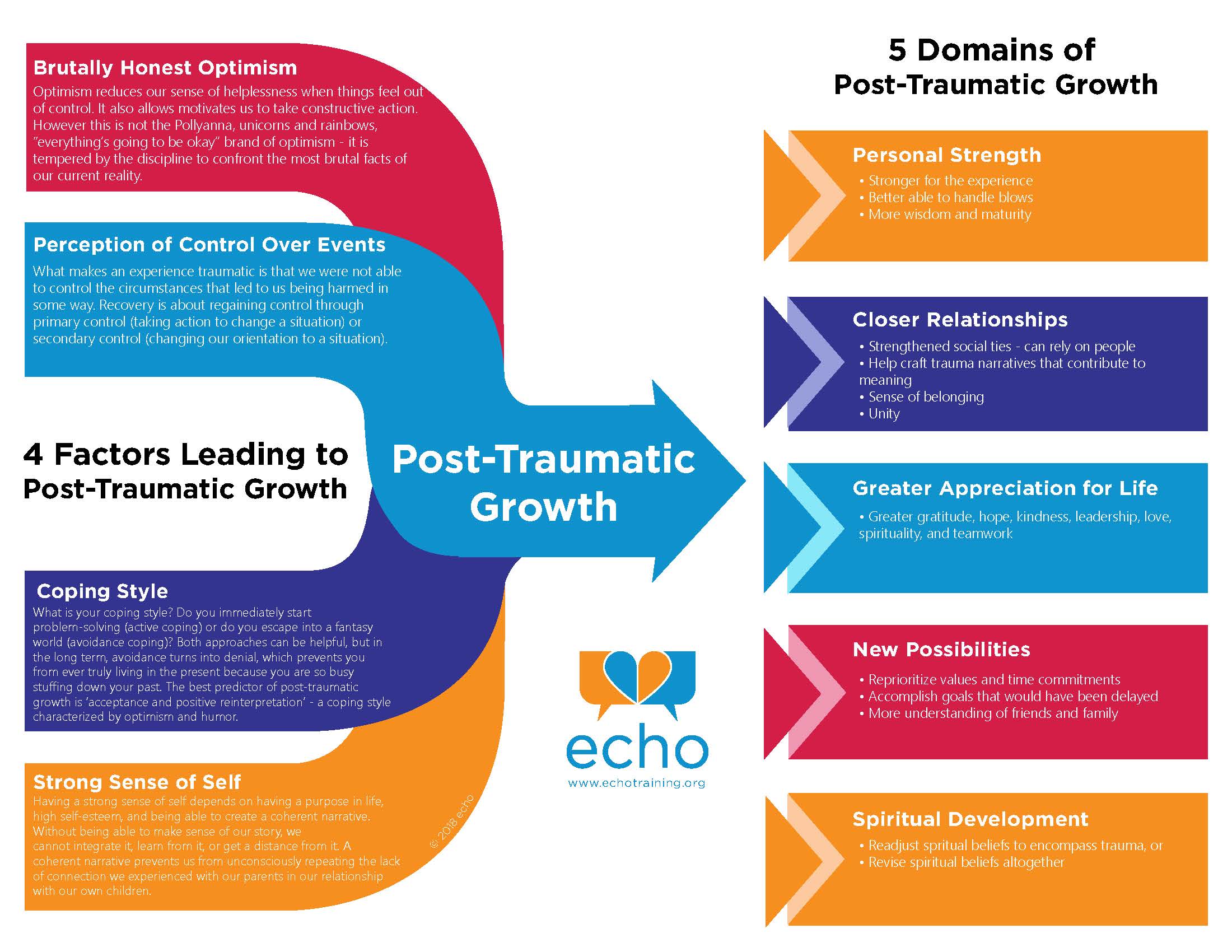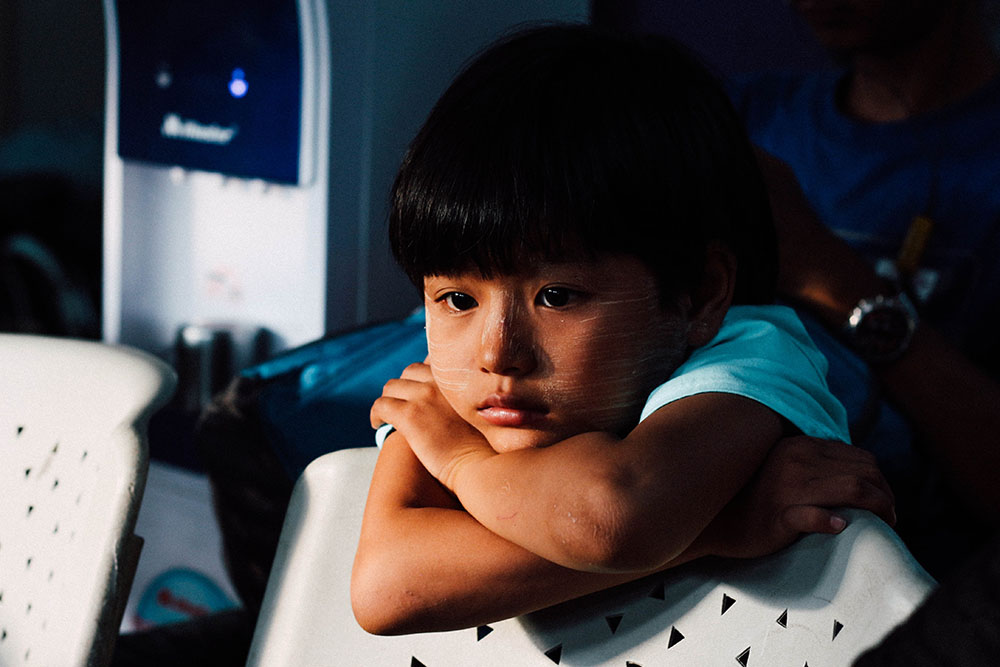
What do you imagine post-traumatic growth looks like? Feeling stronger in the face of a new challenge, knowing we’ve already overcome the worst that life can throw at us? Being more grateful for the little things? More connected to our friends and family? Finding new perspective and priorities? Or maybe having a deeper sense of the mystery and sanctity of life?
The answer is all of the above. In the first part of our article “The Promise of Post-Traumatic Growth” we discussed the four factors that predict whether someone is likely to experience adversity as a catalyst for growth. In this article, we examine what that growth looks like. And, because that’s the way we roll at Echo, we’ve combined the information from both articles in one easy-to-read infographic (see below).
Hear more about post-traumatic growth at our Changing the Paradigm Conference 2018: Frontiers of Resilience, where Jim Rendon will be discussing his book ‘Upside’ in which he interviewed Tedeschi and Calhoun, the foremost researchers in this field, and others whose stories exemplify the power of the human spirit to not just overcome but grow from trauma.

The Five-Domains of Post-Traumatic Growth
Right now, approximately 50% of you who have experienced trauma are reading this and saying, “I’m supposed to be grateful for all the crud that happened to me? Each day, I struggle for even a modicum of what other people take for granted. There’s no amount of ‘growth’ that can stop me wishing this hadn’t been my life.”
Post-traumatic growth is not a given. We’re not going to gloss over the long arduous road to recovery from trauma that for the most part does not feel victorious or courageous for those who are on it. However, at least 50% of survivors have found that they can begin to define themselves and their communities by their strengths and that in no small way these strengths have been forged by adversity.
“Out of the hottest fire comes the strongest steel.” – Chinese proverb
Personal strength
Shaun Tomson is considered one of the top 10 surfing champions of all time. He wrote the best-selling book “Surfer’s Code – 12 Simple Lessons For Riding Through Life” but never imagined he would need every one of those lessons after his 15-year old son died in tragic circumstances. We recently talked about the nature of personal strength in the face of trauma and loss. I proposed that it is not muscle-flexing, heroic poses or stone-faced stoicism, rather the “little tiny spark inside of you that refuses to be extinguished.” Shaun agreed, adding, “I always talk about the light that cannot be extinguished. For me that light is kept alive with hope and prayer.”
Closer relationships
The nature of certain trauma – such as a community tragedy or personal illness – can sometimes bring out the best in those around us. The survivor is surrounded by support and encouragement. It’s easy to see how in this situation post-traumatic growth manifests in a sense of strengthened social ties and the knowledge that people can be relied upon to support us in times of need. Our fellow community or family members can help us make sense of the event and find meaning in what happened through a jointly crafted trauma narrative. Survivors derive a sense of belonging and unity.
For those of us who experienced childhood trauma at the hands of caregivers or other trusted adults, or for those whose trauma is clothed in secrecy because of the shame attached to, for example, sexual abuse or assault, it is much harder to trust people and find the community support we need. However, if we are fortunate enough to encounter the compassion and lack of judgment that is at the heart of what it means to be ‘trauma-informed,’ we too can grow into the closeness and connection that human beings need to thrive.
Greater appreciation for life
It sometimes takes a great setback to appreciate the things you have. After two weeks in bed with the ‘flu, walking around on shaky legs feels like a minor miracle. Walking down the street in a time of great sadness, the electric hues of bougainvillea can stop your heart with its beauty. After 9/11 people reported greater gratitude, hope, kindness, leadership, love, spirituality, and teamwork.
New possibilities
When you’ve experienced just how fragile life is, it makes sense that you would reevaluate your priorities and how you allocate your precious time. The author and poet, Raymond Carver, understood this after being told he would die if he didn’t stop drinking. He quit the alcohol, married Tess Gallagher and when 10 years later he received a terminal cancer diagnosis, wrote the poem ‘Gravy.’
Gallagher outlived Carver, only to receive her own diagnosis of cancer. She talks about how surviving breast cancer gave her a new resolve. “It made me braver about a lot of things. It made me really want to accomplish things that I had put off.”
Some trauma survivors get irked by the definition of resilience as ‘bouncing back’ as they point out that for them there is no ‘back’ to bounce to. Likewise, experiencing trauma in early childhood may mean that there is no sudden reckoning about the transience of life, no course correction or accomplishing of goals that would have been delayed. Common to all types of trauma however, is the possibility of gaining more understanding of our friends and family. At Echo we see this with the parents we teach about generational trauma. It is very hard to come to terms with the harm that has been done to you by your parents, but it becomes easier when you realize that they too were victims of trauma and were doing the best they could with the knowledge and skills available to them.
Spiritual development
“Why did God let this happen?” is a common enough question after trauma. We either have to readjust our spiritual beliefs to encompass trauma or revise them altogether. As Tedeschi and Calhoun note, sometimes this results in a loss of faith and sometimes a deepening of belief. Perhaps you didn’t have a religious or spiritual belief in the first place? The Post-Traumatic Growth inventory developed by Tedeschi and Calhoun is being expanded to include existential themes that resonate with those who are more secular as well as to allow for cross-cultural differences in perceptions of spirituality.
Curious about your own post-traumatic growth? Click here to download the Post-Traumatic Growth Inventory.



